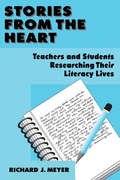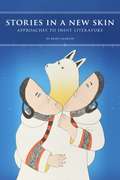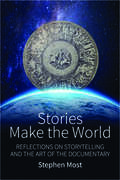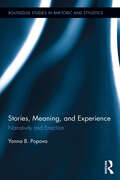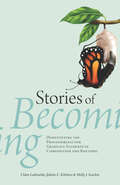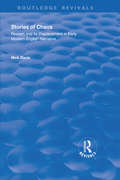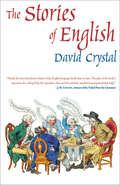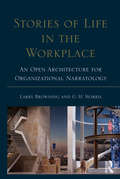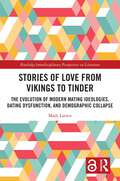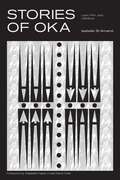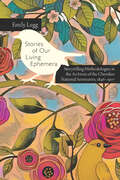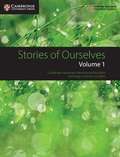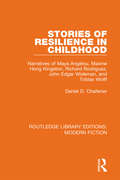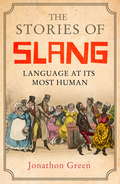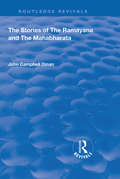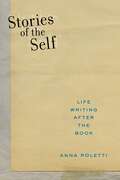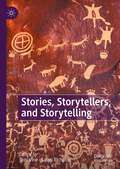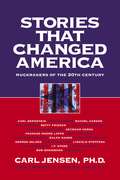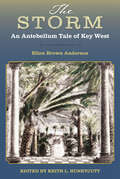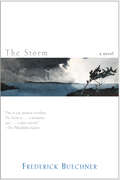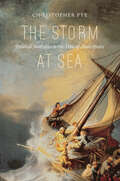- Table View
- List View
Stories From the Heart: Teachers and Students Researching their Literacy Lives
by Richard J. MeyerStories from the Heart is for, by, and about prospective and practicing teachers understanding themselves as curious and literate beings, making connections with colleagues, and researching their own literacy and the literacy lives of their students. It demonstrates the power and importance of story in our own lives as literate individuals. Readers are encouraged to: tell, write, or re-create the stories of their literacy lives in order to understand how they learn and teach; begin the journey into writing the stories of others' literacy lives; find support in their researching endeavors; and examine the idea of framing stories by using the work of other teachers and researchers.
Stories in a New Skin: Approaches to Inuit Literature
by Keavy MartinIn an age where southern power-holders look north and see only vacant polar landscapes, isolated communities, and exploitable resources, it is important to note that the Inuit homeland encompasses extensive philosophical, political, and literary traditions. Stories in a New Skin is a seminal text that explores these Arctic literary traditions and, in the process, reveals a pathway into Inuit literary criticism. Author Keavy Martin considers writing, storytelling, and performance from a range of genres and historical periods – the classic stories and songs of Inuit oral traditions, life writing, oral histories, and contemporary fiction, poetry and film – and discusses the ways in which these texts constitute an autonomous literary tradition. She draws attention to the interconnection between language, form and context and illustrates the capacity of Inuit writers, singers and storytellers to instruct diverse audiences in the appreciation of Inuit texts. Although Eurowestern academic contexts and literary terminology are a relatively foreign presence in Inuit territory, Martin builds on the inherent adaptability and resilience of Inuit genres in order to foster greater southern awareness of a tradition whose audience has remained primarily northern.
The Stories Julian Tells: Instructional Guides For Literature (Julian's World Ser.a\new View Series)
by Ann Cameron Ann StrugnellNIMAC-sourced textbook
Stories Make the World: Reflections on Storytelling and the Art of the Documentary
by Stephen MostSince the beginning of human history, stories have helped people make sense of their lives and their world. Today, an understanding of storytelling is invaluable as we seek to orient ourselves within a flood of raw information and an unprecedented variety of supposedly true accounts. In Stories Make the World, award-winning screenwriter Stephen Most offers a captivating, refreshingly heartfelt exploration of how documentary filmmakers and other storytellers come to understand their subjects and cast light on the world through their art. Drawing on the author's decades of experience behind the scenes of television and film documentaries, this is an indispensable account of the principles and paradoxes that attend the quest to represent reality truthfully.
Stories, Meaning, and Experience: Narrativity and Enaction (Routledge Studies in Rhetoric and Stylistics)
by Yanna B. PopovaThis is a book about the human propensity to think about and experience the world through stories. ‘Why do we have stories?’, ‘How do stories create meaning for us?’, and ‘How is storytelling distinct from other forms of meaning-making?’ are some of the questions that this book seeks to answer. Although these and other related problems have preoccupied linguists, philosophers, sociologists, narratologists, and cognitive scientists for centuries, in Stories, Meaning, and Experience, Yanna Popova takes an original interdisciplinary approach, situating the study of stories within an enactive understanding of human cognition. Enactive approaches to consciousness and cognition foreground the role of interaction in explanations of social understanding, which includes the human practices of telling and reading stories. Such an understanding of narrative makes a decisive break with both text-centred approaches that have dominated structuralist and early cognitivist views of narrative meaning, as well as pragmatic ones that view narrative understanding as a form of linguistic implicature. The intersubjective experience that each narrative both affords and necessitates, the author argues, serves to highlight the active, yet cooperative and communal, nature of human sociality, expressed in the numerous forms of human interaction, of which storytelling is one.
Stories of Becoming: Demystifying the Professoriate for Graduate Students in Composition and Rhetoric
by Claire Lutkewitte Juliette C. Kitchens Molly J. ScanlonBased on findings from a multiyear, nationwide study of new faculty in the field of rhetoric and composition, Stories of Becoming provides graduate students—and those who train them—with specific strategies for preparing for a career in the professoriate. Through the use of stories, the authors invite readers to experience their collaborative research processes for conducting a nationwide survey, qualitative interviews, and textual analysis of professional documents. Using data from the study, the authors offer six specific strategies—including how to manage time, how to create a work/life balance, and how to collaborate with others—that readers can use to prepare for the composition and rhetoric job market and to begin their careers as full-time faculty members. Readers will learn about the possible responsibilities they may take on as new faculty, particularly those that go beyond teaching, research, service, and administration to include navigating the politics of higher education and negotiating professional identity construction. And they will also engage in activities and answer questions designed to deepen their understanding of the field and help them identify their own values and desired career trajectory. Stories of Becoming demystifies the professoriate, compares what current new faculty have to say of their job expectations with the realities that students might face when on the job, and brings to light the invisible, behind-the-scenes work done by new faculty. It will be invaluable to graduate students, those who teach graduate students, new faculty, and hiring administrators in composition and rhetoric.
Stories of Chaos: Reason and its Displacement in Early Modern English Narrative (Routledge Revivals)
by Nick DavisFirst published in 1999, this volume re-examines narrative design in Sir Gawain and the Green Knight, The Faerie Queene, King Lear and Paradise Lost. Written in a period newly set on finding practical application for available systems of reasoning, these texts confront in their different ways reason’s absolute limitation in the face of a Real which it cannot adequately represent to itself or recruit to its own purposes. An influential model for the staging of such a confrontation was the mythic, cosmological narrative of Plato’s Timaeus. In their rewriting of Plato’s narrative the English texts deploy but also destabilize the ancient conceptual polarization of the ‘rational’ and the ‘irrational’ or ‘chaotic’, rethought in the terms offered by their period’s innovatory practices of reasoning. The study establishes the critical importance of telling a story of chaos by comparing the narrative method of its chosen texts with that adopted by Freud and Lacan as a means of reflection on the psychoanalytic encounter with an ultimately chaotic Real. This book has unusual interdisciplinary scope, and offers historically grounded, theoretically informed new readings of four major early modern English literary texts.
The Stories of English: The Persnickety Story Of English Punctuation
by David CrystalA groundbreaking history of worldwide English in all its dialects, differences, and linguistic delights: “Informative . . . distinctive . . . a spirited celebration.” —The GuardianIn this “well-informed and appealing” work (Publishers Weekly), David Crystal puts aside the usual focus on “standard” English, and instead provides a startlingly original view of where the richness, creativity, and diversity of the language truly lies—in the accents and dialects of nonstandard English users all over the world. Whatever their regional, social, or ethnic background, each group has a story worth telling, whether it is in Scotland or Somerset, South Africa or Singapore. He reminds us that for several hundred wonderful years, there was no such thing as “incorrect” English—and traces the evolution of the language from a few thousand Anglo-Saxons to the 1.5 billion people who speak it today.Moving from Beowulf to Chaucer to Shakespeare to Dickens and the present day, Crystal puts regional speech and writing at center stage, giving a sense of the social realities behind the development of English. This significant shift in perspective enables us to understand for the first time the importance of everyday, previously marginalized, voices in our language—and provides an argument too for the way English should be taught in the future.“A work of impeccable scholarship [that] could easily serve as a standard textbook for students of linguistics, but Mr. Crystal, reaching out to a more general audience, recognizes that even the most avid reader might flinch at the sections on Old Norse grammatical influence. Cleverly, he has sprinkled the book with little digressions, set apart in boxes, that address historical mysteries, strange loanwords, interesting etymologies and the like.” —The New York Times“Learned and often provocative . . . demonstrates repeatedly that common conceptions about language are often historically inaccurate—split infinitives bothered no one until recently (likewise sentence-ending prepositions).” —Kirkus Reviews (starred review) “Simply the best introductory history of the English language family that we have. The plan of the book is ingenious, the writing lively, the exposition clear, and the scholarly standard uncompromisingly high.” —J.M. Coetzee, winner of the Nobel Prize in Literature
Stories of Human Rights Module 1 Workbook
by El EducationEL Education is redefining student achievement in diverse communities across the country, ensuring that all students master rigorous content, develop positive character, and produce high-quality work.
Stories of Life in the Workplace: An Open Architecture for Organizational Narratology (Routledge Communication Series)
by George H. Morris Larry BrowningAddressing both renowned theories and standard applications, Stories of Life in the Workplace explains how stories affect human practices and organizational life. Authors Larry Browning and George H. Morris explore how we experience, interpret, and personalize narrative stories in our everyday lives, and how these communicative acts impact our social aims and interactions. In pushing the boundaries of how we perceive narrative and organization, the authors include stories that are broadly applicable across all concepts and experiences. With a perception of narrative and its organizational application, chapters focus on areas such as pedagogy, therapy, project management, strategic planning, public communication, and organizational culture. Readers will learn to: differentiate and gain an in-depth understanding of perspectives from varying narrators; recognize how stories are constructed and used in organizations, and modify the stories they tell; view stories as a means to promote an open exchange of creativity. By integrating a range of theories and practices, Browning and Morris write for an audience of narrative novices and scholars alike. With a distinctive approach and original insight, Stories of Life in the Workplace shows how individuality, developing culture, and the psychology of the self are constructed with language—and how the acceptance of one’s self is accomplished by reaffirming and rearranging one’s story.
Stories of Love from Vikings to Tinder: The Evolution of Modern Mating Ideologies, Dating Dysfunction, and Demographic Collapse (Routledge Interdisciplinary Perspectives on Literature)
by Mads LarsenIncreasing levels of singledom, dating dysfunction, and sexual inactivity contribute to plummeting fertility rates. This book investigates the perhaps most foundational factor behind this uncoupling: our present era’s ideology of love. Throughout human history, communities have shared fictional stories infused with various mating moralities that compel people to pair-bond and reproduce. After taking readers on a 6-million-year journey through hominin mating regimes—with various extents of promiscuity, polygyny, and monogamy—Stories of Love from Vikings to Tinder investigates the past millennium's radical evolution of Western mating beliefs. Nordic literary works illuminate the pivotal transitions between the West’s First, Second, and Third Sexual Revolutions, which occurred around the years 1200, 1750, and 1968. The conclusion chapter points to the Fourth Sexual Revolution, symbolically placed in 2029. Artificial intelligence and other technologies seem likely to transform our mating practices more radically than any of the previous revolutions.
Stories of Oka: Land, Film, and Literature
by Isabelle St. Amand S. E. Stewart Katsitsén:hawe Linda David CreeIn the summer of 1990, the Oka Crisis—or the Kanehsatake Resistance—exposed a rupture in the relationships between settlers and Indigenous peoples in Canada. In the wake of the failure of the Meech Lake Accord, the conflict made visible a contemporary Indigenous presence that Canadian society had imagined was on the verge of disappearance. The 78-day standoff also reactivated a long history of Indigenous people’s resistance to colonial policies aimed at assimilation and land appropriation. The land dispute at the core of this conflict raises obvious political and judicial issues, but it is also part of a wider context that incites us to fully consider the ways in which histories are performed, called upon, staged, told, imagined, and interpreted. "Stories of Oka: Land, Film, and Literature" examines the standoff in relation to film and literary narratives, both Indigenous and non-Indigenous. This new English edition of St-Amand’s interdisciplinary, intercultural, and multi-perspective work offers a framework for thinking through the relationships that both unite and oppose settler societies and Indigenous peoples in Canada.
Stories of Our Living Ephemera: Storytelling Methodologies in the Archives of the Cherokee National Seminaries, 1846-1907
by Emily LeggStories of Our Living Ephemera recovers the history of the Cherokee National Seminaries from scattered archives and colonized research practices by critically weaving together pedagogy and archival artifacts with Cherokee traditional stories and Indigenous worldviews. This unique text adds these voices to writing studies history and presents these stories as models of active rhetorical practices of assimilation resistance in colonized spaces. Emily Legg turns to the Cherokee medicine wheel and cardinal directions as a Cherokee rhetorical discipline of knowledge making in the archives, an embodied and material practice that steers knowledge through the four cardinal directions around all relations. Going beyond historiography, Legg delineates educational practices that are intertwined with multiple strands of traditional Cherokee stories that privilege Indigenous and matriarchal theoretical lenses. Stories of Our Living Ephemera synthesizes the connections between contemporary and nineteenth-century academic experiences to articulate the ways that colonial institutions and research can be Indigenized by centering Native American sovereignty. By undoing the erasure of Cherokee literacy and educational practices, Stories of Our Living Ephemera celebrates the importance of storytelling, especially for those who are learning about Indigenous histories and rhetorics. This book is of cultural importance and value to academics interested in composition and pedagogy, the Cherokee Nation, and a general audience seeking to learn about Indigenous rhetorical devices and Cherokee history.
Stories Of Ourselves: Cambridge Assessment International Education Anthology Of Stories In English (Cambridge International Examinations Ser.)
by University of Cambridge ESOL ExaminationsThis series contains poetry and prose anthologies composed of writers from across the English-speaking world. Parts of Stories of Ourselves Volume 1 are set for study in Cambridge IGCSE®, O Level and International AS & A Level Literature in English courses. Each short story in this collection has its own unique voice and point of view. They may differ in form, genre, style, tone and origin, but all have been chosen because of their wide appeal. Written in English by authors from different countries and cultures, the anthology includes works by Charles Dickens, H.G. Wells, Virginia Woolf, Graham Greene, V.S. Naipaul, R.K Narayan, Janet Frame, Raymond Carver, Jhumpa Lahiri, Annie Proulx and many others.
Stories of Resilience in Childhood: Narratives of Maya Angelou, Maxine Hong Kingston, Richard Rodriguez, John Edgar Wideman and Tobias Wolff (Routledge Library Editions: Modern Fiction)
by Daniel D. ChallenerWhat helps a child overcome extraordinary obstacles? Why do some children surmount many difficulties and go on to live fulfilling lives while other children who face similar difficulties end up living desperate, sad lives? What helps children beat the odds? What builds resilience in children? These are critically important questions, yet for too long social scientists, doctors, psychologists and teachers have studied children who failed and tried to figure out what caused the failure. Only relatively recently have they begun to focus on what creates success. Originally published in 1997, this book is an effort to understand better what contributes to a child’s "success" and "resilience". The source of information will be autobiographies of childhoods – autobiographical stories written by adults remembering their difficult childhoods. This is not a research study or case study, rather it is an attempt to read and listen to five stories about resilient children and see what they can tell us about supporting children and building resilience.
The Stories of Slang: Language at its most human
by Jonathon Green'By turns bawdy, sweary and irreverent, this book . . . is a fascinating look at how centuries of slang came to inform all aspects of social life, how it was used, and how much of it still lingers.' History RevealedLike the flesh-and-blood humans whose uncensored emotions it represents, slang's obsessions are sex, the body and its functions, and intoxication: drink and drugs. Slang does not do kind. It's about hatreds - both intimate and and national - about the insults that follow on, the sneers and the put-downs. Caring, sharing and compassion? Not at this address. There are over 10,000 terms focusing on sex, but love? Not one.Jonathon Green, aka 'Mr Slang', has drawn on the 600,000-plus citations that make up his magisterial Green's Dictionary of Slang (published 2010, now online at www.greensdictofslang.com) to tell some of slang's most entertaining stories. Categories range from The Body to Pulp Diction, via multi-cultural London English and pun-tastic gems.Mostly gazing up from the gutter, slang, perhaps surprisingly, also embraces the stars. These stories may look at drunken sailors, dubious doctors, and a shelf of dangerously potent cocktails, but slang does class acts as well. None more so than Shakespeare. Devotee of the double entendre, master of the pun, first to put nearly 300 slang terms in print. 'Shakespeare, uses, at my count, just over five hundred "slang" terms, of which 277 are currently the first recorded use of a given term. Among these are the beast with two backs, every mother's son, fat-headed, heifer (for woman), pickers and stealers (hands), small beer (insignificant matters), what the dickens, and many more.'http://jonathongreen.co.uk
The Stories of Slang: Language at its most human
by Jonathon Green'If you're up for an adventure through the back alleys of English, The Stories of Slang will not disappoint.' Kory Stamper, Times Literary Supplement'Few lexicographers are lucky enough to have both endlessly pleasurable work and the talent to write amusingly about [slang]. Jonathon Green is one . . . Lovers of language should be grateful to those who create slang, and to those few like Mr Green who make it their work to open this window into the psyche for the benefit of all.' - The Economist'By turns bawdy, sweary and irreverent, this book . . . is a fascinating look at how centuries of slang came to inform all aspects of social life, how it was used, and how much of it still lingers.' History RevealedLike the flesh-and-blood humans whose uncensored emotions it represents, slang's obsessions are sex, the body and its functions, and intoxication: drink and drugs. Slang does not do kind. It's about hatreds - both intimate and and national - about the insults that follow on, the sneers and the put-downs. Caring, sharing and compassion? Not at this address. There are over 10,000 terms focusing on sex, but love? Not one.Jonathon Green, aka 'Mr Slang', has drawn on the 600,000-plus citations that make up his magisterial Green's Dictionary of Slang (published 2010, now online at www.greensdictofslang.com) to tell some of slang's most entertaining stories. Categories range from The Body to Pulp Diction, via multi-cultural London English and pun-tastic gems.Mostly gazing up from the gutter, slang, perhaps surprisingly, also embraces the stars. These stories may look at drunken sailors, dubious doctors, and a shelf of dangerously potent cocktails, but slang does class acts as well. None more so than Shakespeare. Devotee of the double entendre, master of the pun, first to put nearly 300 slang terms in print. 'Shakespeare, uses, at my count, just over five hundred "slang" terms, of which 277 are currently the first recorded use of a given term. Among these are the beast with two backs, every mother's son, fat-headed, heifer (for woman), pickers and stealers (hands), small beer (insignificant matters), what the dickens, and many more.'http://jonathongreen.co.uk
The Stories of the Ramayana and the Mahabharata: The Great Indian Epics 1899 (Routledge Revivals)
by John Campbell OmanFirst published in 1900, this volume reproduces the key events of the Ramayana and Mahabharata Indian epics. It emerged amongst significant academic interest in Indian culture and literature. Whilst many Indian histories had provided abstracts and full texts of the two epics presented here, this book provided reproductions of the main incidents and striking features of these two otherwise imposing, lengthy works. The volume deals with each text separately and presents several key excerpts along with a general introduction and introductory remarks for both texts.
Stories of the Self: Life Writing after the Book (Postmillennial Pop #27)
by Anna PolettiThe importance of personal storytelling in contemporary culture and politicsIn an age where our experiences are processed and filtered through a wide variety of mediums, both digital and physical, how do we tell our own story? How do we “get a life,” make sense of who we are and the way we live, and communicate that to others? Stories of the Self takes the literary study of autobiography and opens it up to a broad and fascinating range of material practices beyond the book, investigating the manifold ways people are documenting themselves in contemporary culture. Anna Poletti explores Andy Warhol’s Time Capsules, a collection of six hundred cardboard boxes filled with text objects from the artist’s everyday life; the mid-aughts crowdsourced digital archive PostSecret; queer zine culture and its practices of remixing and collaging; and the bureaucratic processes surrounding surveillance dossiers. Stories of the Self argues that while there is a strong emphasis on the importance of personal storytelling in contemporary culture and politics, mediation is just as important in establishing the credibility and legibility of life writing. Poletti argues that the very media used for writing our lives intrinsically shapes how we are seen to matter.
Stories, Storytellers, and Storytelling
by Tom Vine Sarah RichardsThis book advances social scientific interest in a field long dominated by the humanities: stories, and storytelling. Stories are a whole lot more than entertainment; oral narratives, novels, films and immersive video games all form part of the sociocultural discourses which we are enmeshed in, and use to co-construct our beliefs about the world around us. Young children use them to learn about the world beyond their immediate sensory experience and, even in an era of interactive electronic media, the bedtime story remains a cherished part of most children’s daily routine. Storytelling is thus the first abstract formal learning method we encounter as human beings. It is also probably transcultural; perhaps even an immanent part of the human condition. Narratives are, at heart, sequences of events and presuppose and reinforce particular cause-and-effect relationships. Inevitably, they also construct unconscious biases, prejudices, and discriminatory attitudes. Storying (a term we use in this book to encompass stories, storytellers and storytelling) is complex, and this book seeks to make sense of it.
Stories that Changed America: Muckrakers of the 20th Century
by Hugh Downs Carl JensenExuberantly written, highly informative, Jensen's Stories That Changed America examines the work of twenty-one investigative writers, and how their efforts forever changed our country. Here are the pioneering muckrakers, like Upton Sinclair, author of the fact-based novel The Jungle, that inspired Theodore Roosevelt to sign the Pure Food and Drug Act into law; "Queen of the Muckrakers" Ida Mae Tarbell, whose McClure magazine exposés led to the dissolution of Standard Oil's monopoly; and Lincoln Steffens, a reporter who unearthed corruption in both municipal and federal governments. You'll also meet Margaret Sanger, the former nurse who coined the term "birth control"; George Seldes, the most censored journalist in American history; Nobel Prize-winning novelist John Steinbeck; environmentalist Rachel Carson; National Organization of Women founder Betty Friedan; African American activist Malcolm X; consumer advocate Ralph Nader; and Bob Woodward and Carl Bernstein, the Pulitzer Prize-winning reporters whose Watergate break-in coverage brought down President Richard Nixon. The courageous writers Jensen includes in this deftly researched volume dedicated their lives to fight for social, civil, political and environmental rights with their mighty pens.
The Storm: An Antebellum Tale of Key West
by Ellen Brown AndersonA newly discovered manuscript believed to be the first known novella written by a woman in Florida In 2015, an unsigned and undated 98-page manuscript was donated to the University of Florida. This work, titled The Storm, is published here for the first time, transcribed and annotated by Keith Huneycutt. Huneycutt presents evidence attributing its authorship to Ellen Brown Anderson, a writer who came to Florida and lived with family members before the Civil War. This book makes widely available what may be the first novella written by a woman in the state.Likely written between 1854 and 1862, The Storm is set in Key West during the hurricane year of 1846. It is narrated by a young bride who tells the story of her first marriage, her struggle to make sense of a loveless and hopeless domestic situation, and the restrictions placed on women in her society. The story also presents a woman’s viewpoint on mid-nineteenth-century Key West, including the island’s shipwreck salvage industry and the town’s get-rich-quick economy, constituting one of the first fictional treatments of the Keys’ wrecking business.Huneycutt’s introduction compares the text with other examples of women’s literature and works by Florida authors from the period. The appendixes include essays on the writings of Anderson and her sister Corrina Brown Aldrich, who may have also played a role in the tale’s creation. Huneycutt argues that The Storm is groundbreaking in many ways and that it deserves serious consideration as part of antebellum American literature.
The Storm: A Novel
by Frederick BuechnerThe Boston Globe calls Frederick Buechner "one of our finest writers." USA Today says he's "one of our most original storytellers." Now this acclaimed author gives us his most beguiling novel yet--a magical tale of love, betrayal, and redemption inspired by Shakespeare's The Tempest.On wealthy Plantation Island in South Florida, an old man waits, Kenzie Maxwell is a writer, a raconteur, a rascal, an altruist, a mystic--a charismatic figure who enjoys life with his rich third wife but muses daily on the sins of his past. Two decades ago, Kenzie had to leave New York because of a scandal. He'd been a volunteer at a runawat shelter, and he'd fallen in love with a seventeen-year-old girl--a girl who died while giving birth to Kenzie's daughter. His older brother, Dalton, a lawyer and board member at the shelter, decided to quell the rumors by releasing Kenzie's note of apology to the press. Kenzie's reputation--and the girl's--were destroyed. He has never forgiven his brother.Now it's the eve of Kenzie's seventieth birthday, and a storm is brewing. His beloved daughter, Bree--the child of the scandal--is coming down from New York for his birthday party. But his brother Dalton is coming down, too, to do some legal work for the island's ill-tempered matriarch. Aided and abetted by Dalton's happy-go-lucky stepson, a loutish gardener, a New Age windsurfer, a bumbling bishop, and a bona fide tempest, Kenzie must somehow contrive to reconcile with his brother--and make peace with his past.Infused with humanity, and informed by faith. The Storm is Frederick Buechner's most captivating novel since Godric--a richly satisfying contemporary story of fragmented families and love's many mysteries that will move you, makeyou laugh, and fill you with wonder.
The Storm (Fountas & Pinnell LLI Green #Level E, Lesson 74)
by Anna MccartFountas and Pinnell Leveled Literacy Intervention Green System -- 1st Grade
The Storm at Sea: Political Aesthetics in the Time of Shakespeare
by Christopher PyeThe Storm at Sea: Political Aesthetics in the Time of Shakespeare counters a tradition of cultural analysis that judges considerations of aesthetic autonomy in the early modern context to be either anachronistic or an index of political disengagement. Pye argues that for a post-theocratic era in which the mise-en-forme of the social domain itself was for the first time at stake, the problem of the aesthetic lay at the very core of the political; it is precisely through its engagement with the question of aesthetic autonomy that early modern works most profoundly explore their relation to matters of law, state, sovereignty, and political subjectivity.Pye establishes the significance of a “creationist” political aesthetic—at once a discrete historical category and a phenomenon that troubles our familiar forms of historical accounting—and suggests that the fate of such an aesthetic is intimately bound up with the emergence of modern conceptions of the political sphere.The Storm at Sea moves historically from Leonardo da Vinci to Thomas Hobbes; it focuses on Shakespeare and English drama, with chapters on Hamlet, Othello, A Winter’s Tale, and The Tempest, as well as sustained readings of As You Like It, King Lear, Thomas Kyd’s Spanish Tragedy, and Christopher Marlowe’s Doctor Faustus. Engaging political thinkers such as Carl Schmitt, Giorgio Agamben, Claude Lefort, and Roberto Esposito, The Storm at Sea will be of interest to political theorists as well as to students of literary and visual theory.
